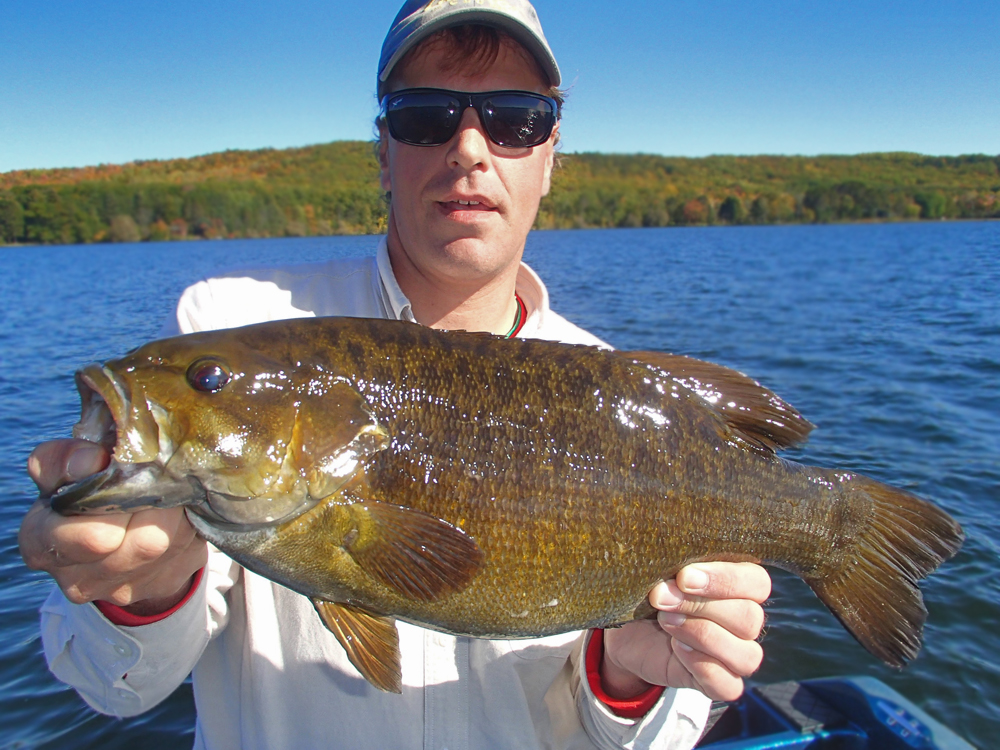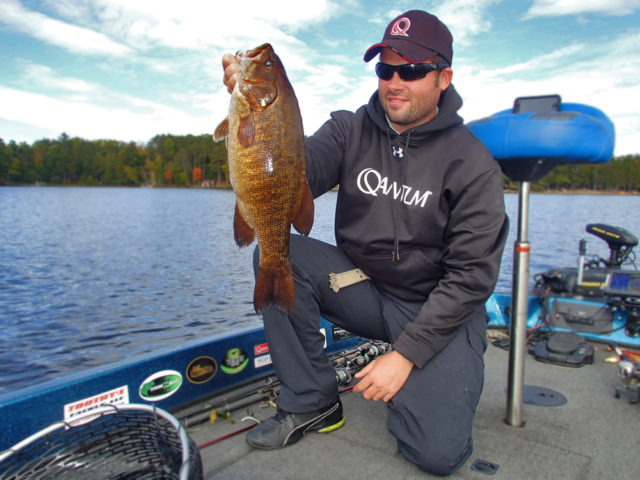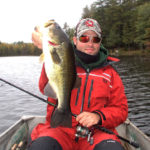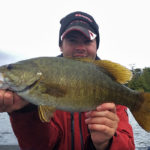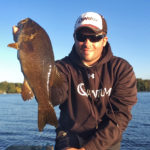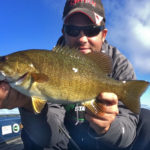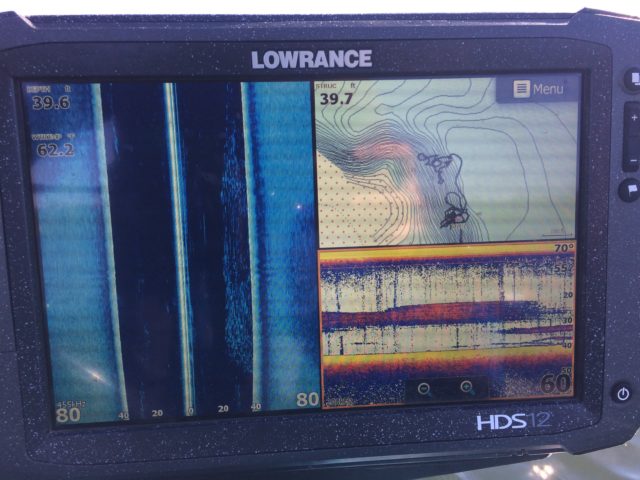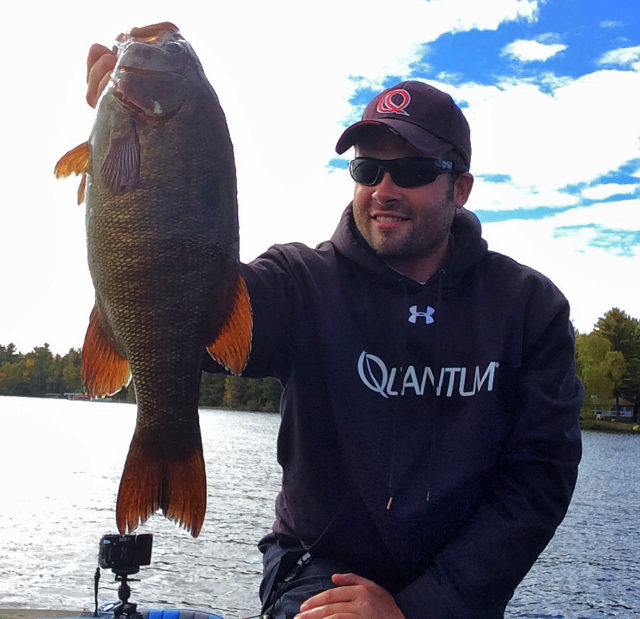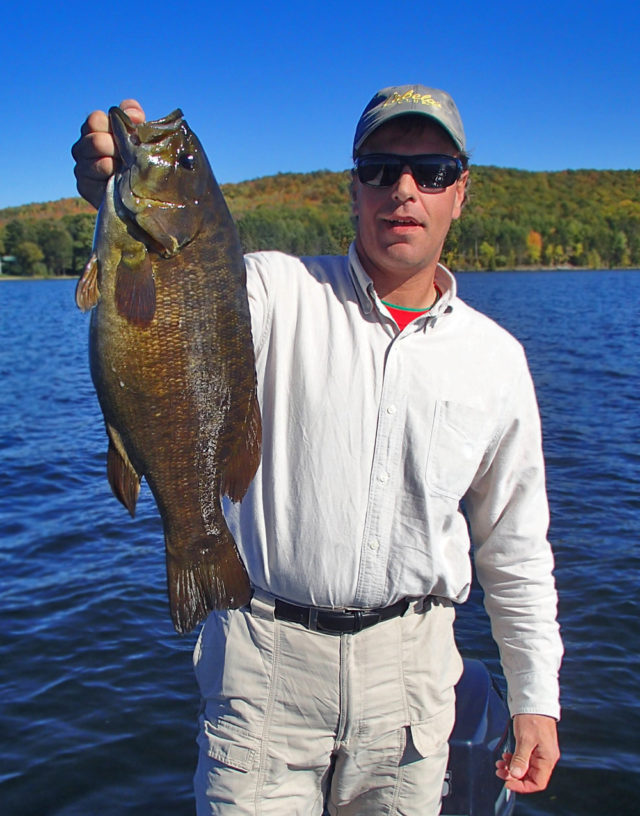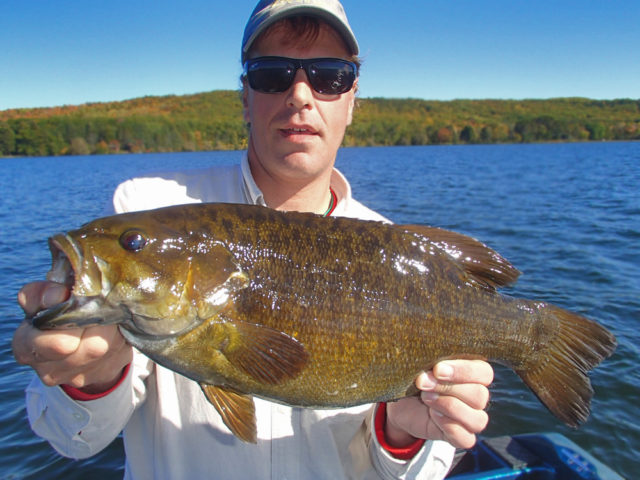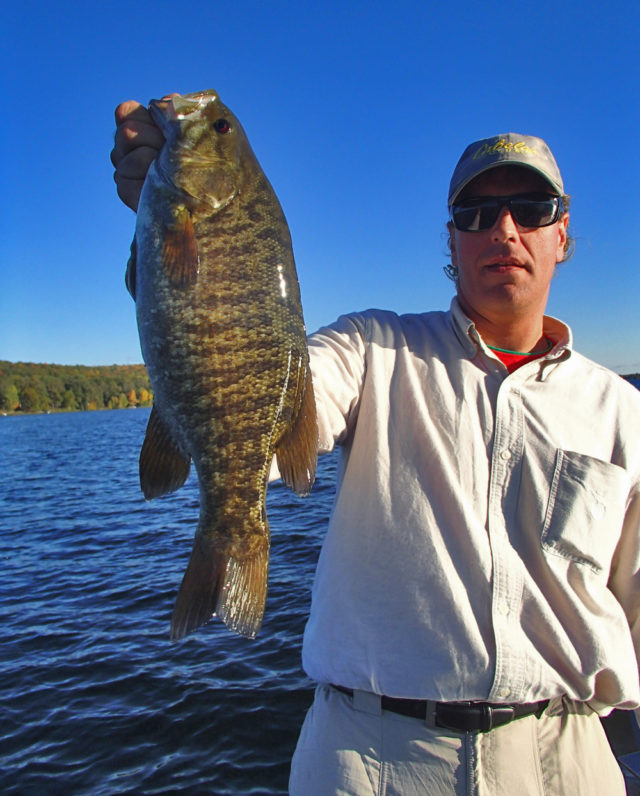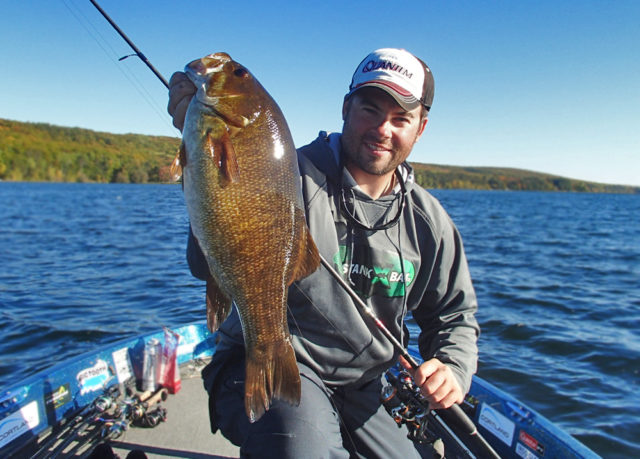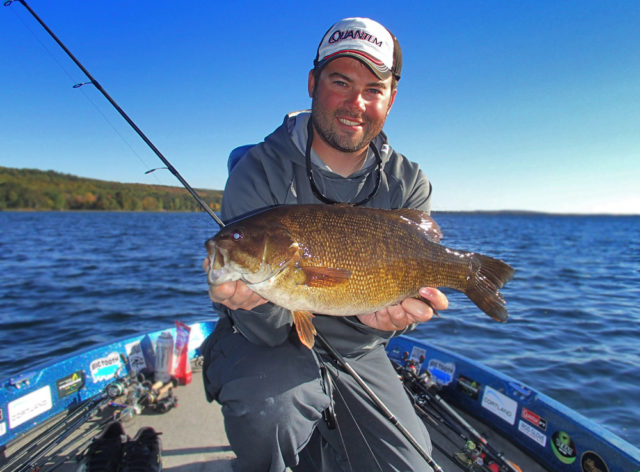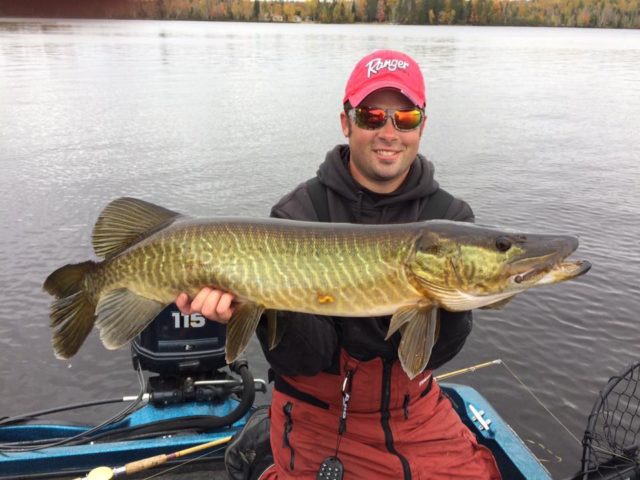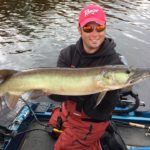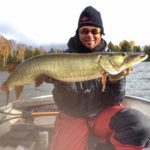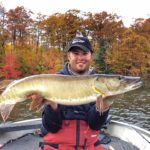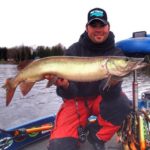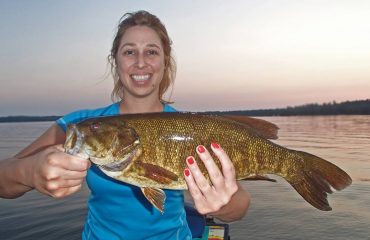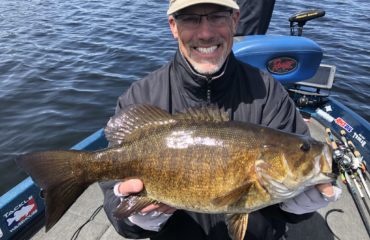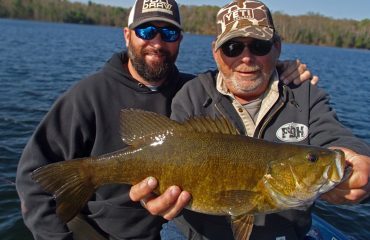Northwoods Bass Fishing Report, October 2016
The month of October has passed, and so has my 2016 bass fishing season. My bass fishing wrapped up during the week of October 9th, and after lots of musky and multi-species fishing the Ranger was winterized on October 21st. Our fall season has been confused and I’m not quite sure it knows what to do. Shouldn’t it keep getting colder, and not warmer? The reality is I should still be bass fishing, but having now winterized and closed up the house these circumstances assures me that I’m done until next May.
The warm weather and Indian summer we experienced this month prolonged the fall shallow water feeding and bass movements. The warm climate consequently delayed the turnover process, and what anglers got to enjoy was a greatly-extended pre-turnover fishing period that lasted through mid October. This rarely happens, as usually by second week of the month turnover passes and water temperatures in most places would be in the upper 40 to low 50 degree range. Turnover hadn’t begun on most lakes until the third week of October.
Although the calendar turns to November 1st on Tuesday, we’re about 2 weeks behind schedule in where fall fishing and patterns really should be. At this writing, water temperatures on many lakes are still consistently registering 50-53 degrees!
Although crappy weather canceled an entire week’s-worth of guided bass dates I had scheduled for the first week of the month, October fishing started off on fire in the Minocqua area. Each coldfront that passed through this month grew progressively worse. And each event followed by its post-frontal conditions drove the bass deep even further. While these fronts slowed the fishing, they engaged some of the lake’s largest bass into feeding on some days.
Bass were schooling and setting up location in average depths of 15 to 30 feet. In other places they were holding much deeper, beyond 30ft for overwintering. This time of season, the crayfish have migrated deep, and so have most of their favorite prey fish consisting of shiners, suckers, yellow perch, and ciscoes. Early in the month, lots of shallow water feeding along sandbars and rock bars was observed. By mid month, that all changed and bass were down deep.
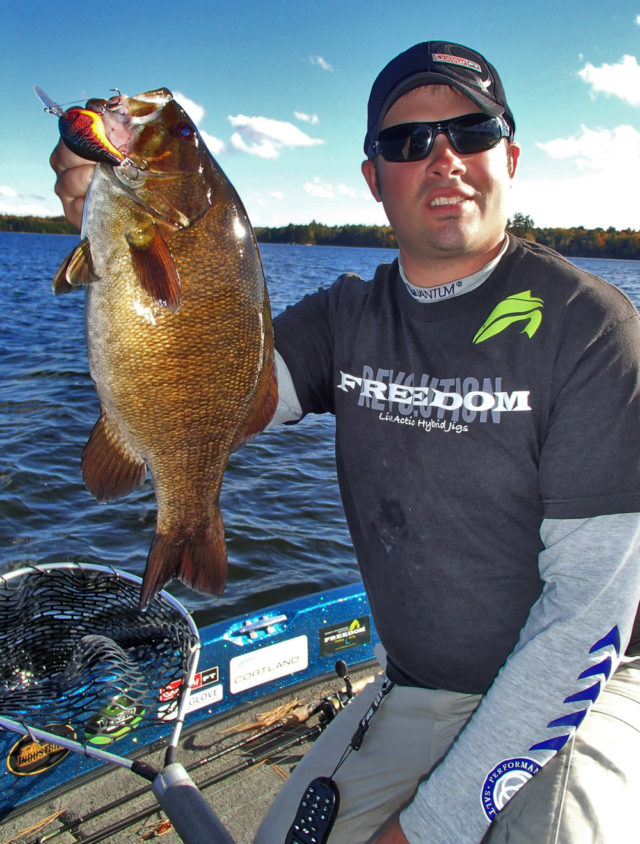 An observation I made this month was how very few of my fish were chasing fast moving baits, and being engaged into reactionary strikes. Slow and subtle presentations from dragging tube jigs, hula grubs, and football jigs caught fish. Vertical jigging with flukes, spoons and blade baits, and drop shotting techniques caught fish also. Rigging with live bait, done as the last resort, caught fish also. Occasionally, a deep diving crankbait such as a Rapala DT-10 and 16, or swim jig and swimming grub retrieved slowly through mid-depth ranges triggered strikes, but not with same frequency as all these slow and subtle strategies.
An observation I made this month was how very few of my fish were chasing fast moving baits, and being engaged into reactionary strikes. Slow and subtle presentations from dragging tube jigs, hula grubs, and football jigs caught fish. Vertical jigging with flukes, spoons and blade baits, and drop shotting techniques caught fish also. Rigging with live bait, done as the last resort, caught fish also. Occasionally, a deep diving crankbait such as a Rapala DT-10 and 16, or swim jig and swimming grub retrieved slowly through mid-depth ranges triggered strikes, but not with same frequency as all these slow and subtle strategies.
The month didn’t offer much for numbers other than a few 20 fish outings early on. Most days were grinds, with 5 to 10 fish of moderate to large size being the daily norm. This late in the season, I don’t care for numbers. We want big fish.
In order to locate most of this month’s biggest bass, we had to motor around and slowly idle around key spots and wintering locations before fish were confirmed on the screen. Only then, with waypoints marked and a track established, would we even consider fishing and drifting the specific location.
Once bass were found, they were really easy to catch. And when caught, my observation was that 90 percent of the bass were utilizing and setting up in only 10 percent of the lake.
While deep schooling, non-dormant bass are often catchable, the presence of nearby food greatly enhanced catching them. The food needed to be present down deep where smallmouths were beginning to home for the winter. Schools of yellow perch and baitballs were often nearby.
Worthwhile locations and money spots were fish cribs and deep wood in the 15 to 20ft zones. These wooded structures held bass. Additionally, deep rocks with nearby mud transitions from 25 to 29 feet held bass most frequently. Steep breaklines and shelves dropping into deep water held fish as well.
With big fish on my mind in October, I only focused my bass fishing efforts on 5 different lakes throughout the month. Yes, I only camped on 5 out of some 3,000 different lakes in my region. Due to short feeding windows and the unpredictability of turnover this year, it didn’t make sense to drive all over the place and lake hop like normally. The lakes I limited myself to in October tend to fish well for bass in fall. It helps to understand their specific fall bass movements, and know where wintering holes are located.
A strategy that helped catch more fish in October was avoiding being on waters with a lot of weed decay and pre-turnover blooms and clarity discoloration. These places were dead seas. Our best bites came from large deep clear waters, and lakes that never stratify.
Although most of October’s bass fishing was done locally in the Minocqua region, a few long-distance travel days were made. These last few years I’ve been fishing more frequently in Forest County. I always return to Minocqua impressed of their quality world-class bass fisheries. Forest County bass fishing has resulted in some of my boat’s largest ever smallmouth bass captured. Forest County resulted in my boat’s biggest bass captured in 2016.
This year’s largest was boated October 3rd. I met up with my good friend Johnny Amato and we tangled into some huge smallmouth bass. John caught my boat’s largest of the year, and his personal best. Measuring 21.5″, and weighing in at a hefty 6lbs, 4oz.
Extracted from 27 ft depths live bait rigging with 4 to 5 inch walleye suckers, John’s slow and careful fight with the monster was epic. After a few quick shots and high fives she swam back down to winter, and to become a 7 pounder for next year.
Even though we only caught a meager 7 fish during the full 12 hour day, each specimen was quality. Our expectation of big fish only was met and exceeded.
Live bait fishing like Amato and I had resorted to doing is effective. I only recommend fishing this way when done correctly and responsibly. When schooling in mass numbers, smallmouths are vulnerable to exploitation. And when holding deep, they are prone to barotrauma when brought up, as well as frequent gut-hookings due to the nature they suck in the live minnow. Unless fishing with circle hooks, smallmouths will rarely gut hook themselves. By slowly taking your time fighting and playing the fish, I assure you that barotraumas and burst swim bladders will rarely happen.
Live bait rigging for smallmouths is most effective when fished stupid simple. Fished on 7 ft. medium to medium-heavy fast action spinning rods with 8 to 12 lb. monofilament or 10 to 15 lb. superbraid, equip yourself with a 3/8 oz. to ½ oz. walking sinker attached to your main line, followed by a ball bearing swivel and 1 to 2ft section of 8 to 12 lb. fluorocarbon leader tied to your livebait hook of choice.
My recommendation is circle hooks only, but my favorite for livebait smallmouth fishing has become Eagle Claw Trokar’s TK 15 Wide Load Hook. It has a wider gap than most traditional livebait hooks, and it’s the closest model to a circle hook that I’ve found. Trokar’s assortment of circle hooks in the TK 619 variety is superb as well. What makes the live bait rig work is the liveliness of your minnow. 4 to 5 inch walleye sucker minnows, rigged from lower jaw through nostril, is most ideal and hearty, followed by blacktail and redtail chubs. The live minnow swimming in distress is irresistible to smallmouths holding deep.
By the weekend of October 9th, my bass season came to an end. I was more fixated on catching other species and the remainder of my up north season was fished for muskies.
The trips during my first season of bass guiding were few as a result of my lack of prominent advertising and promotion, but our outings were memorable and wildly successful. Thank you friends and guests who took a chance on me this year, and hired “the new guy”. I had tons of fun. I look forward to bass fishing with you all again next year, and more scheduled trips.
I am already booking dates and scheduling for May/June. Mail-in deposit, sent 30 days in advance, will be required to hold and reserve your dates. The phone line and e-mail is open for inquiries and discussion. I will also be attending sport shows to do some exhibiting. I will also holding speaking engagements this winter and early next spring throughout the Chicagoland area – my offseason home. These dates are TBD and when confirmed I will post announcements on my website and facebook page.
Next season will be underway the week of May 8th, 2017.
Andrew Ragas
Northwoods Bass Fishing Adventures, LLC
Licensed and Insured
Specializing in Northern Wisconsin inland bass fishing
tel: 708-256-2201
email: andrew@northwoodsbass.com
web: www.northwoodsbass.com


